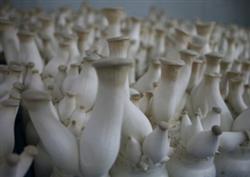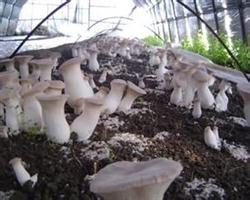What are the common problems in growing Pleurotus eryngii?
What are the common problems in growing Pleurotus eryngii? How to prevent the cultivation of Pleurotus eryngii common problems are: first, bacterial bag pollution. The direct cause of most bacterial bag pollution is that the sterilization is not complete. Under the conditions of suitable moisture and temperature, the miscellaneous bacteria that did not kill in the bag began to multiply, at first scattered on the bag, and then expanded into pieces. The reasons for incomplete sterilization are as follows: 1. When mixing, the culture material does not absorb water, and there is a raw core in the material, especially in the hard culture materials such as sawdust, corncob and so on. two。 The cold air is not exhausted in the sterilization process, and the sterilization pot is always occupied by cold air, resulting in no good thermal cycle. 3. The problem of incomplete sterilization will occur if the sterilization time is insufficient, or there is a cease-fire in the sterilization process, or if the bacteria bags in the sterilization pot are placed too much and too tight. Second, the mycelium grows slowly. 1. The weak viability of the strain can cause the mycelium to grow slowly. The purchase of bacteria must be purchased from a unit with a larger scale and high reputation. The suitable age of the strain is generally 30-40 days, and the hyphae are white, dense and sturdy, indicating strong vitality. two。 The bacterial bag is too tight or the water content is too high (more than 65%). Due to the lack of sufficient oxygen in the bacterial bag, the growth rate of mycelium is inhibited. 3. If the bacteria temperature is too low, such as less than 20 ℃, poor ventilation or unsuitable pH of the culture material (the suitable ph is about 7), it will also cause the bacteria to grow slowly. Third, mushrooms appear on the side of the bag, and there are many deformities in the process of sterilization, the bags squeeze each other and the round bags are deformed, resulting in a gap between the cultivation material and the bag, which provides air and space for the twisting of hyphae. Coupled with low temperature, light stimulation and mechanical stimulation (such as inverted bag, etc.), the hyphae on the side of the bag were twisted to form primordia and developed into fruiting bodies. Due to the limitation of plastic bags, this kind of mushroom is all deformed. If this happens, the mushroom bud should be pinched in time to stop its growth, so as not to cause more waste of nutrition. Fourth, the fruiting body is small and the commodity rate is low. The reason for this is that there is no thinning of buds. After primordium differentiation, many small mushroom buds grew on both sides of the bag, ranging from several to dozens. However, due to the limitations of nutrition and space, most of these mushroom buds can not grow into commercial mushrooms, so they should be thinned to avoid wasting nutrition. The principle of sparse buds is that when mushroom buds are formed, 4-6 buds with good position, normal shape and similar size are left on each side, and when the fruiting body grows to about two centimeters, another selection is made, leaving 2-4 buds on each side. In this way, a higher commodity rate can be guaranteed. Fifth, the mycelium grows vigorously. During the emergence of mushrooms, the hyphae suddenly grew, both ends of the bag and the fruiting body were covered with white hyphae, and the fruiting body began to shrink from the middle of the cap, and when serious, the fruiting body yellowed and died. This is mainly due to the sudden increase in temperature in the mushroom shed. In the stage of mushroom emergence, both hyphae and fruiting bodies are growing, and under normal circumstances, the two kinds of growth reach dynamic balance. The balance is determined by temperature. the relatively high temperature is beneficial to the growth of mycelium and the lower temperature is beneficial to the differentiation of primordium. The sudden heating up broke the original balance and made the mycelium growth dominant. In the case of a certain amount of nutrition and water, more nutrition and water supply to the mycelium growth, less nutrition and water supply to the fruiting body, serious nutrient reflux of the fruiting body, showing atrophy of the fruiting body in appearance, even withering and death. Sudden heating in the mushroom shed should be prevented. Click to get more cultivation techniques of Pleurotus eryngii
- Prev

What is the cultivation process of Pleurotus eryngii?
What should we pay attention to in cultivating Pleurotus eryngii? Pleurotus eryngii is one of the newly developed species of edible fungi in recent years. Because its cultivation technology is not yet popular, some problems encountered in production often affect the yield, so attention must be paid to it. The main results are as follows: 1. Most of the bacterial bags are contaminated in the process of bacteria, and when they are serious.
- Next

How to cultivate Pleurotus eryngii with bag material for high yield
How can Pleurotus eryngii cultivated with bag material produce high yield? Pleurotus eryngii is a kind of large fleshy umbrella fungus with good quality, which belongs to Pleurotus ostreatus, Pleurotus ostreatus. Fruit body solitary or group, thick meat, slow umbrella opening, dense stalk tissue, snow-white thick, few spores, long shelf life, different from ordinary Pleurotus ostreatus, fresh taste.
Related
- Fuxing push coffee new agricultural production and marketing class: lack of small-scale processing plants
- Jujube rice field leisure farm deep ploughing Yilan for five years to create a space for organic food and play
- Nongyu Farm-A trial of organic papaya for brave women with advanced technology
- Four points for attention in the prevention and control of diseases and insect pests of edible fungi
- How to add nutrient solution to Edible Fungi
- Is there any good way to control edible fungus mites?
- Open Inoculation Technology of Edible Fungi
- Is there any clever way to use fertilizer for edible fungus in winter?
- What agents are used to kill the pathogens of edible fungi in the mushroom shed?
- Rapid drying of Edible Fungi

